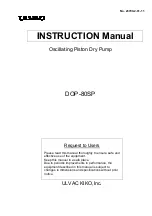
2
JAN 16/19
5.0
Before first use
Read this manual and all warnings in its entirety.
Identify the fluid type and expiration date of the fluid to be
used in the tank. We suggest marking with a black permanent
marker on a self-adhesive write-on label or clear cellophane tape
affixed onto the tank in the silver square for contrast.
Flow a few cups of oil through the valve assembly and hose to
flush any contaminants remaining from the assembly process and to
purge any remaining air.
Use only the type of fluid for which this servicing unit has been
designed. Other fluids will damage seals and the integrity of the
unit.
6.0
Normal Operation
1)
Remove the pump cartridge and insure there are no foreign objects
/ liquids in the top of the pump cartridge unit (reference figure
1).
2)
Fill the tank with 1 gallon of appropriate fluid.
3)
Snug tighten the pump cartridge by hand. Do not over tighten, or
the cartridge will flatten the sealing gasket away from the
sealing surface and a leak will occur.
4)
Pump up to operating pressure of 20-25psi.
5)
Connect hose to the service pump and purge the line of air by
slowly operating the flow valve with the end of the hose
discharging into a cup until only fluid comes out, then close
flow valve.
6)
Appropriately connect servicing hose to the reservoir to be
serviced.
7)
With tank upright, operate flow valve to service reservoir. Do
not tilt the tank during this process. This is so that the
internal straw does not cavitate and suck air into the system.
8)
When servicing of the reservoir is completed, close flow valve,
disconnect hose, attach dust cap onto coupler, and slowly unscrew
pump cartridge to relieve air pressure from the tank.
7.0
Storage
Store unit in the following manner:
A.
Unpressurized indoors, below 75°F, and away from sunlight.
B.
In such a way as to prevent foreign objects / liquids from
entering at the top of the pump cartridge (figure 1). When the
pump rod is actuated to pressurize the tank, these
contaminants can be sucked into the cartridge and pushed into
the tank. While the filter will remove solids, it cannot
distinguish between other liquids.
Summary of Contents for HYDRA-PRO AP-XXX120-2
Page 2: ......



























